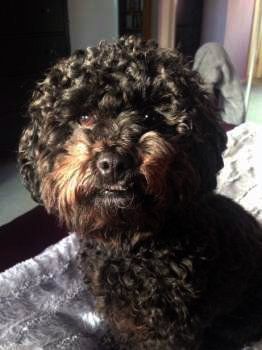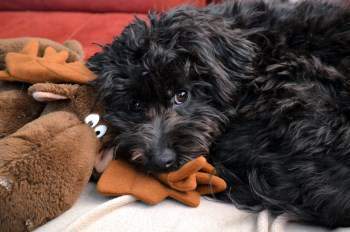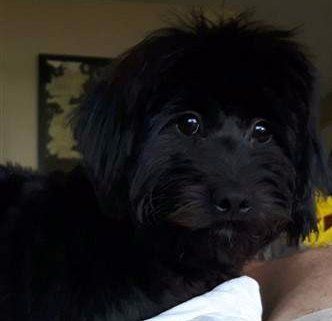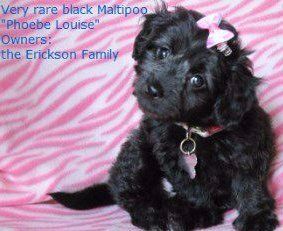Black Maltipoos
Overview
Since the Maltipoo is a cross of a toy Poodle which can be found in a wide range of colors with solid or parti-black being part of that and a Maltese which is only found in white or cream (white is the preferred standard color), you may wonder how in the world mixing those two could produce black Maltipoos.
Many assume that the white would mix with the black to produce a gray... or another theory is that it would produce a parti-colored dog (a coat that has two, clear distinct colors).
However, genes are at play here (both dominant and recessive), so it gets a bit more complicated than just the two colors of the dam and sire mixing.
Black Maltipoos are very rare, but they certainly do exist. This section will go into this with more detail to explore one of the most gorgeous and sought-after coats of this amazing hybrid dog.
This black Maltipoo's coat texture is influenced by the Maltese; though it holds the Poodle color of black, the texture is soft and silky.
Zoey, Photo courtesy of Cathy Zakrzewski
True Black Maltipoos
To understand a bit more about black Maltipoo puppies and dogs, we must look to the Poodle, since this coat color is not found in the bloodline of the Maltese.
And it is in that breed that there are some interesting things happening in regard to black. While it may not be very apparent that a Poodle has two different layers of hair, he certainly does. Since black is such a popular yet rare color for this breed as well, studies have been performed to take a closer look.
It was found that the majority of those black coats (70%) were black from tip to root. However, the other 30% were blue or grey near the roots. Due to the root color, 64% of those dogs had a color change as they matured. In some cases, the hairs grew out to be blue or gray and for a smaller number, some white even grew in.
Therefore, 'true' black Maltipoos will follow suit; they will have black hairs from root to tip and will not change color as the puppy coat falls out to be replaced by the adult coat.
One of the other elements of black Maltipoo dogs is that if the coat is truly black, the eyes will be black as well. You will find a solid black with brown eyes; and if you do, there is a good chance that coat will either turn or fade (if we are talking about a puppy) or that the coat is blue. Now, if a Maltipoo is predominantly black but has a secondary color, the eyes may be black however they may also be any shade of brown; this means that they will range from a light hazel to a dark almond.
What a beautiful sikly black!
Vito, at 6 months old
Photo courtesy of Peter Szaraz
This Maltipoo has a 50/50 blend of both curly Poodle hair and soft Maltese hair.
Genes Responsible for Coloring and Hair Texture
Since the Maltese holds no other color than white
(and some may be cream due to less-than-topknotch breeding practices, the black must be brought down from the Poodle. One may then wonder if having a black coat will mean that the hair texture will mimic that of the Poodle as well.
You may be interested to know that two completely different genes are responsible for color and texture.
Locus K genes are responsible for the color black. The KRT71 gene (if it is there or a lack of it) controls whether or not a coat is curly. The FGF5 produces the longer, straighter coat. Therefore, if a black Maltipoo did not receive the KRT71 gene, his coat will be soft and with a slight wave. If he received both the KRT71 and FGF5, he will have a semi-tight coat or what we would refer to as a 50:50 blend of both parents. If the KRT71 is passed down, the black Maltipoo will lean much more toward resembling a Poodle, with wiry, tightly curled hairs.
Parti-Blacks
More common with Maltipoos is the parti-colored coat as opposed to the solid. If the dog has more than 50% black and any other secondary color, he will be a black-parti. Therefore, the second color may be anywhere from 1 to 49%. However, with this said, normally if the second color is 10% or less, it would be termed a 'mismark' and therefore the Maltipoo would be a black mis-mark.
Just about any other color may accompany black. Common are red, tan and brown.
The Sunburning Effect
Black coats, if exposed to too much sunlight can develop red tinting over a period of time. This is often referred to as sunburning although it does not affect the skin in any way. While the previously black hairs that end up having red highlights may still be in good condition, it is not uncommon for them to be a bit dried out.
If you have a black Maltipoo and want him to retain his coloring, you will want to use a quality leave-in spray each day. This will add a thin layer of protection to the hair strands for when you take him out for walks, bathroom trips and whatnot. It is important to remember that one day out in the sun will not affect a black coat... It is day after day... adding up to months and years that can add reds and lighter highlights.
Therefore, getting into a daily routine of using your leave-in product will ensure that you can let your Maltipoo enjoy the outdoors without any concerns that it will end up changing his beautiful black color.

This black Maltipoo (with brown markings) has strong Poodle genes, giving her a very curly coat.
Molly, 1 year old
Photo courtesy of Theresa Ball
Additionally, you may wish to consider using a color enhancing shampoo. A good enhancer will not dye the hair, but rather it will work to bring out the natural shades and deepen the ebony hairs while adding shine.




